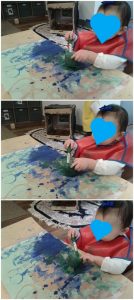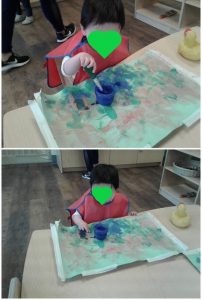“Repetition is the secret of perfection” – Doctor Maria Montessori
Some of our best childhood memories may include making rice crispy squares or chocolate chip cookies till we got them right. But what was the process to that accomplishment? It was the act of “repetition”: each try had the same ingredients, bowls and recipe. Every single moment was unique and has a different recollection. Every effort may have some more materials added or taken away and some of us may even be confident in repeating the process without looking at the recipe.
“Repetition – the recurrence of an action or event. (Oxford Learners Dictionary)

Painting with watercolours
The same holds true for young children: the more “repetition” the stronger are the neural connections in the brain associated with those tasks. “Repetition” also enhances physical coordination, builds concentration and confidence. Duplicating actions, words or materials provides a sense of predictability and stability. The child can recollect and participate in the moment, based on their previous experiences, which builds self-esteem and pride over their acquired skills.
The Fir room at Mongio Early Learning Center is a home away from home to our youngest children. Very often teachers will present and provide “repetition” of sensory experiences. Our aim is to involve all the senses; one such example is the popular music to the all-time favourite chicken dance. Crawling and walking children will congregate to the location of the sound and in their own way participate. Teachers energetically participate and as we all know enthusiasm is contagious. Another example is painting with watercolors. The substance, “watercolors” remains constant while the medium of painting varies every time the skill is repeated. Educators take advantage of natural phenomenon to expand the child’s understanding of painting: during the recent snow experiences, Fir room children were painting on snow. Since then the children have painted on construction paper, cardboard and even plastic, growing their understanding of painting and watercolours.

At this tender age children do have a short attention span and as such settling with one activity for a long period of time can be an unrealistic expectation. The need for “repetition” is crucial if we want to see our young children grow and thrive. If you see a child signing “more” it the brain asking you for a repetitive experience as it is now ready to learn. But don’t hesitate to put limits on some activities also. If a child wants you to read/sing their favourite book/song for the tenth time, it’s okay to put an end to the marathon and promise another reading /singing later. And children will hold you to your promise.
Resources:
Oxford Learner’s Dictionaries: Find definitions, translations, and grammar explanations at Oxford Learner’s Dictionaries. (n.d.). Retrieved from https://www.oxfordlearnersdictionaries.com/
(2017, May 4). Repetition and Child Development in Montessori Education. Retrieved from https://montessoriacademy.com.au/repetition-child-development-montessori/
Anonymous. (2019, January 5). Why Toddlers Love Repetition. Retrieved from https://www.parents.com/toddlers-preschoolers/development/behavioral/why-toddlers-love-repetition/



